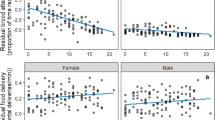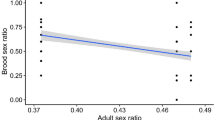Abstract
Recently, a number of studies have found adaptive brood sex ratio (BSR) manipulation in birds. The reason for such manipulations is thought to be the different reproductive value of male and female nestlings. Several studies have found that parental quality and food supply can affect BSR, however results are sometimes inconsistent between species and populations. We investigated BSR patterns in a Hungarian population of Collared Flycatchers (Ficedula albicollis) and compared the results with those obtained in a previous study of the same species in Sweden. We found two significant differences. First, the male forehead patch size, a heritable, sexually selected trait, affected the brood sex ratio in the Swedish population, but not in our Hungarian study population. This difference might be a consequence of the different information content of the forehead patch size in the two populations. Second, a seasonal shift in BSR (more sons late in the season) was observed in the Hungarian, but not in the Swedish population.


Similar content being viewed by others
References
Badyaev AV, Hill GE, Beck ML, Dervan AA, Duckworth RA, McGraw KJ, Nolan PM, Whittingham LA (2002) Sex-biased hatching order and adaptive population divergence in a passerine bird. Science 295:316–318
Badyaev AV, Beck ML, Hill G, Whittingham LA (2003) The evolution of sexual size dimorphism in the house finch v. maternal effects. Evolution 57:384–396
Bensch S (1999) Sex allocation in relation to parental quality. Proc Int Ornithol Congr 22:451–456
Burley N (1981) Sex ratio manipulation and selection for attractiveness. Science 211:721–722
Crawley MJ (1993) GLIM for Ecologists. Blackwell Science Ltd., Oxford
Ellegren H, Fridolfsson A-K (1997) Male-driven evolution of DNA sequences in birds. Nat Genet 17:182–184
Ellegren H, Gustafsson L, Sheldon BC (1996) Sex ratio adjustment in relation to paternal attractiveness in a wild bird population. Proc Natl Acad Sci USA 93:11723–11728
Emlen ST (1997) When mothers prefer daughters over sons. Trends Ecol Evol 12:291–292
Fridolfsson A-K, Ellegren H (1999) A simple and universal method for molecular sexing of non-ratite birds. J Avian Biol 30:116–121
Garamszegi LZs, Møller AP, Török J, Michl G, Péczely P, Richard M (2004) Immune challenge mediates vocal communication in a passerine bird: an experiment. Behav Ecol 15:148–157
Gustafsson L, Qvarnström A, Sheldon BC (1995) Trade-offs between life history traits and a secondary sexual character in male collared flycatchers. Nature 375:311–313
Hasselquist D (1998) Polygyny in great reed warblers: a long-term study of factors contributing to male fitness. Evolution 79:2376–2390
Hasselquist D, Kempenaers B (2002) Parental care and adaptive brood sex ratio manipulation in birds. Philos Trans R Soc Lond B 357:363–372
Hegyi G, Török J, Tóth L (2002) Qualitative population divergence in proximate determination of a sexually selected trait in the collared flycatcher. J Evol Biol 15:710–719
Kölliker M, Heeb P, Werner I, Mateman AC, Lessells CM, Richner H (1999) Offspring sex ratio is related to male body size in the great tit (Parus major). Behav Ecol 10:68–72
Komdeur J (1998) Long-term fitness benefits of egg sex modification by the Seychelles warbler. Ecol Lett 1:56–62
Komdeur J, Pen I (2002) Adaptive sex allocation in birds: the complexities of linking theory and practice. Philos Trans R Soc Lond B 357:373–380
Krackow S (1999) Avian sex ratio distortions: The myth of maternal control. Proc Int Ornithol Congr 22:425–433
Krackow S, Tkadlec E (2001) Analysis of brood sex ratios: implications of offspring clustering. Behav Ecol Sociobiol 50:293–301
Krebs EA, Green DJ, Double MC, Griffith R (2002) Laying date and laying sequence influence the sex ratio of crimson rosella broods. Behav Ecol Sociobiol 51:447–454
Leech DI, Hartley IR, Stewart IRK, Griffith SC, Burke T (2001) No effect of parental quality or extrapair paternity on brood sex ratio in the blue tit (Parus caeruleus). Behav Ecol 12:674–680
Lessells CM, Mateman AC, Visser J (1996) Great tit hatchling sex ratios. J Avian Biol 27:135–142
Michl G, Török J, Griffith SC, Sheldon BC (2002) Experimental analysis of sperm competition mechanisms in a wild bird population. Proc Natl Acad Sci USA 99:5466–5470
Møller AP, Brohede J, Cuervo JJ, de Lope F, Primmer CR (2003) Extrapair paternity in relation to sexual ornamentation, arrival date, and condition in a migratory bird. Behav Ecol 14:707–712
Nishiumi I (1998) Brood sex ratio is dependent on female mating status in polygynous great reed warblers. Behav Ecol Sociobiol 44:9–14
Oddie K (1998) Sex discrimination before birth. Trends Ecol Evol 13:130–131
Oddie K, Reim C (2002) Egg sex ratio and paternal traits: using within-individual comparisons. Behav Ecol 13:503–510
Petrie M, Schwabl H, Brande-Lavridsen N, Burke T (2001) Sex differences in avian yolk hormone levels. Nature 412:498-499
Qvarnström A (1999) Genotype-by-environment interactions in the determination of the size of a secondary sexual character in the collared flycatcher (Ficedula albicollis). Evolution 53:1564–1572
Qvarnström A, Pärt T, Sheldon BC (2000) Adaptive plasticity in mate preference linked to differences in reproductive effort. Nature 405:344–346
Radford AN, Blakey JK (2000) Is variation in brood sex ratios adaptive in the great tit? Behav Ecol 11:294–298
SAS Institute (1990) SAS procedures guide, version 6, 3rd edn. SAS Institute, Cary, N.C., USA
Schwabl H (1996) Maternal testosterone in the avian egg enhances postnatal growth. Comp Biochem Phys A 114:271–276
Sheldon BC, Ellegren H (1999) Sexual selection resulting from extrapair paternity in collared flycatchers. Anim Behav 57:285–298
Sheldon BC, Merilä J, Qvarnström A, Gustafsson L, Ellegren H (1997) Paternal genetic contribution to offspring condition predicted by size of male sexual character. Proc R Soc Lond B 264:297–302
Sheldon BC, Merilä J, Lindgren G, Ellegren H (1998) Gender and environmental sensitivity in Collared Flycatchers. Ecology 79:1939–1948
Sheldon BC, Andersson S, Griffith SC, Örnborg J, Sendecka J (1999) Ultraviolet colour variation influences blue tit sex ratios. Nature 402:874–877
Sokal RR, Rohlf FJ (1981) Biometry, 2nd edn. Freeman, New York
Svensson E, Nilsson J-Å (1996) Mate quality affects offspring sex ratio in blue tits. Proc R Soc Lond B 263:357–361
Svensson L (1992) Identification guide to european passerines. Märstatryck, Stockholm
Teather KL, Weatherhead PJ (1989) Sex specific mortality in nestling great-tailed grackles. Ecology 70:1485–1493
Török J, Michl G, Garamszegi LZs, Tóth L (1999) Costs and benefits in a complex mating system from female perspective. Adv Ethol 34:185
Török J, Hegyi G, Garamszegi LZs (2003) Depigmented wing patch size is a condition-dependent indicator of viability in male collared flycatchers. Behav Ecol 14:382–388
Westerdahl H, Bensch S, Hansson B, Hasselquist D, von Schantz T (2000) Brood sex ratios, female harem status and resources for nestling provisioning in the great reed warbler (Acrocephalus arundinaceus). Behav Ecol Sociobiol 47:312–318
Whittingham LA, Schwabl H (2002) Maternal testosterone in tree swallow eggs varies with female aggression. Anim Behav 63:63–67
Acknowledgements
We thank Gergely Hegyi, Eszter Szöllősi and Rita Hargitai for their help in the field, Csaba Fekete, and David S. Richardson whose advice greatly helped the laboratory work, and Bengt Hansson who helped with statistical advice. The comments of two anonymous referees considerably improved the manuscript. The study was supported by the Hungarian State Eötvös Fellowship to B.R., the Hungarian Scientific Research Found (OTKA 34880) to J.T., the Swedish Council for Environment, Agricultural Sciences and Spatial Planning (Formas), the Carl Trygger Foundation, the Crafoordska Foundation to D.H., the Swedish Research Council to S.B., the Eötvös Loránd University and the Pilis Park Forestry. The present study complies with the current laws of Hungary.
Author information
Authors and Affiliations
Corresponding author
Additional information
Communicated by J. Graves
Rights and permissions
About this article
Cite this article
Rosivall, B., Török, J., Hasselquist, D. et al. Brood sex ratio adjustment in collared flycatchers (Ficedula albicollis): results differ between populations. Behav Ecol Sociobiol 56, 346–351 (2004). https://doi.org/10.1007/s00265-004-0796-3
Received:
Revised:
Accepted:
Published:
Issue Date:
DOI: https://doi.org/10.1007/s00265-004-0796-3




